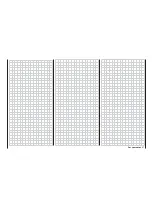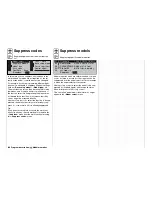
71
Program description:
Basic settings
dard elevator servo. The elevator trim
lever affects both servos.
In this mode a transmitter control
which is assigned to input 8 in the
»
Transmitter control
adjust
« menu
is de-coupled from servo “8”; this is
for safety reasons.
Please read the notes in the section starting on page
37 regarding receiver output sequences.
Ailerons / camber-changing fl aps
In this menu point you set the number of aileron and
fl ap servos installed in the model to be programmed.
Available options:
Control channel used
“1
AIL”
2
“2 AIL”
2 + 5
“1 AIL 1 FL”
2 / 6
“2 AIL 1 FL”
2 + 5 / 6
“2 AIL 2 FL”
2 + 5 / 6 + 7
“2 AIL 4 FL”
2 + 5 / 6 + 7 / 9 + 10
The functions required, and the methods of setting
them up, vary according to the selected number of
wing fl aps; they are programmed in the »
Wing mi-
xers
« menu (see page 110).
Tips:
• In the »
Wing mixers
« menu (page 110) the fl ap
settings can be trimmed for all pairs of wing cont-
rol surfaces (AIL, FL and FL2), separately for each
fl ight phase.
• The fl ap function of all pairs of wing control sur-
faces (AIL, FL and FL2) can also be operated
using the “Throttle / airbrake stick”, provided that
this is not already in use for another purpose, e. g.
for particular brake settings; see »
Wing mixers
«
menu (page 110). To implement this all you need
to do is assign “Control 1” to input 6 in the »
Trans-
mitter control adjust
« menu (see page 78). If you
prefer to use a switch to control the fl aps, we re-
commend a two-position or three-position trans-
mitter switch.
• Additional wing-mounted servos can be integra-
ted into the programming in a very simple manner
using the »
Dual mixers
« menu (see page 144).
For more details please refer to the programming
example on page 184.
Brake
This function is likely to interest electric-powered mo-
del enthusiasts, and pilots of glow-powered models
which are also fi tted with landing fl aps.
The mixers described in the “Brake settings” line of
the »
Wing mixers
« menu can be controlled using the
C1 stick (“Input 1”), one of the side-mounted proporti-
onal controls, or one of the switches connected to “In-
put 7, 8 or 9” (see the »
Transmitter control adjust
«
menu). The setting is entered in the usual way using
the rotary control.
In most cases the setting will be left at the default of
“Input 1”, and the brake will be controlled using the
non self-neutralising C1 stick. However, the use of in-
put 7, 8 or 9 enables you to operate the brake using
an alternative auxiliary control if the C1 stick is alrea-
dy in use for another purpose. Inputs 7 and 8 are also
included in the fl ight phase specifi c control switching
group in the »
Transmitter control adjust
« menu,
which makes it possible, for example, to disable the
brakes in individual fl ight phases, if you so desire.
The mixer neutral point (“Offset”) can be shifted to
any point you wish: move the transmitter control for
input 1, 7, 8 or 9 to the position at which the landing
fl aps are to be at neutral, then select
STO
to defi ne
this as the “Offset” point:
STO
Offset
+90%
Normal
2 AIL
SEL
O D E L T Y P E
er flaps
Input 1
None
If the Offset point is not located right at the end of the
control travel, the remaining travel is a “dead zone”,
i. e. it no longer affects any of the mixers set up un-
der “Brake settings” in the »
Wing mixers
« menu.
This dead zone ensures that all the brake settings re-
main at “neutral” even if the airbrake control is moved
slightly away from its end-point. At the same time the
effective travel of the transmitter control is automati-
cally expanded back to 100%.
Note:
If you wish to control a brake system and a “Motor at
C1” alternately using the C1 stick, then set up “Brake”
and “Motor” to suit your preferences in this menu – as
already mentioned under “Motor on C1” – and then
set the “Motor” column in this column of the »
Pha-
se settings
« menu (see page 100) to “yes” or “no” for
each fl ight phase as required.
Tip:
The servo assigned to operate wing-mounted airbra-
kes is best connected to the receiver output which
is controlled by the brake input channel, i. e. we re-
commend that you connect the airbrake servo to the
(vacant) receiver output 8, if you have selected Input
8 for “Brake”, etc.. If a second airbrake servo is pre-
sent, the simplest method of actuating it is to use a
free mixer.
100
%
90%
Summary of Contents for mx-24s
Page 1: ...1...
Page 19: ...19 For your notes...
Page 35: ...35 For your notes...
Page 41: ...41 41 For your notes...
Page 57: ...57 For your notes...
Page 63: ...63 63 For your notes...
Page 69: ...69 69 For your notes...
Page 85: ...85 85 For your notes...
Page 99: ...99 For your notes...
Page 143: ...143 For your notes...
Page 191: ...191 For your notes...
Page 212: ...212 212 For your notes...
Page 213: ...213 213 For your notes...
Page 214: ...214 For your notes...
Page 216: ...216...
















































